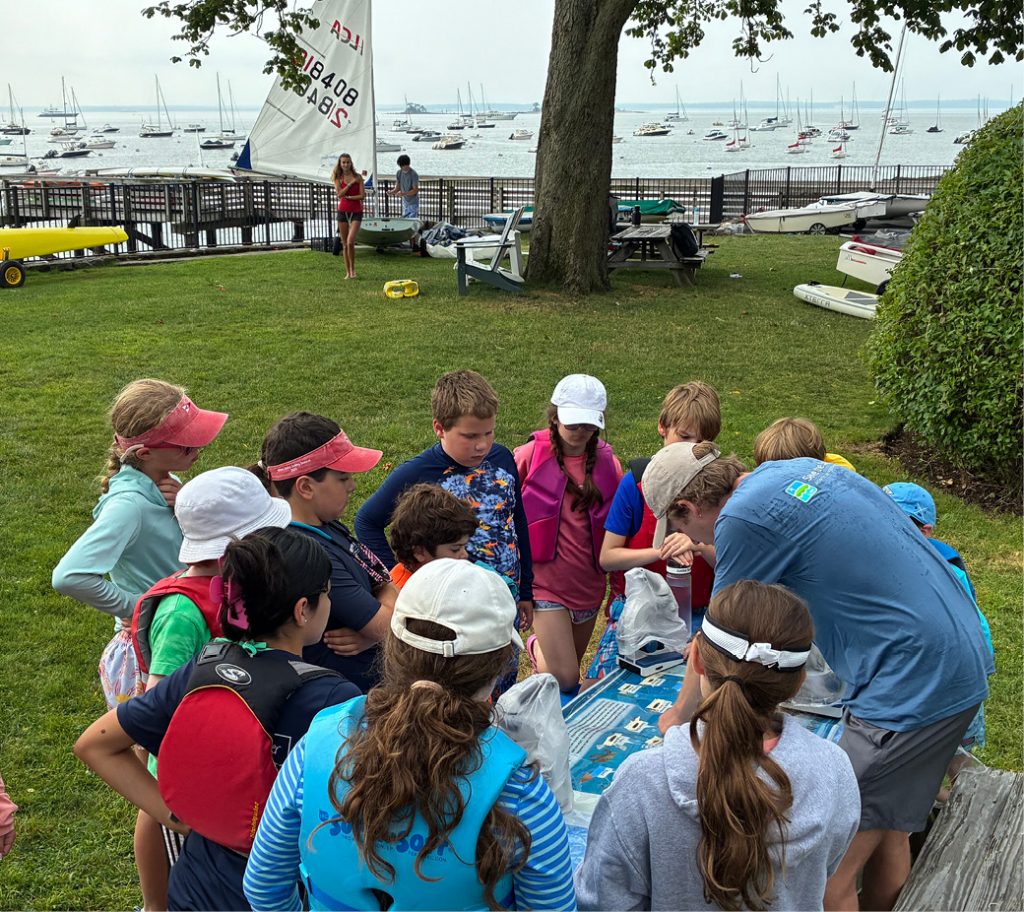On one side of a wooden picnic table, Adi Kolff leaned over a colorful poster depicting a busy harbor, with cartoon kayaks, sailboats, and powerboats sharing the water.
More than a dozen campers hovered around the sides of the table, looking out from under the brims of their visors, baseball caps, and bucket hats. At their backs was another busy waterbody—a real one, where dozens of sailboats bobbed on their moorings on a hazy July morning.

Young sailors learn about the inhabitants of the waters on which they sail in Save the Sound’s Sound Advocates program.
Everyone’s attention was fixed on the oversized seascape poster spread out across the table. Under the boats were illustrations of marine debris: paper towels and plywood, wool socks and cotton gloves, apple cores and aluminum cans. Short strips of masking tape obscured the answers to the question Adi prompted the kids to guess:
How long will each type of trash remain in the water?
Some guesses were close. Others were off by a couple of centuries. But whenever tape was peeled and answers revealed, it elicited a collective gasp of disbelief. Plastic bottles last 400+ years. “What?” Discarded fishing line lasts 600. “Whoa!”
If this doesn’t sound like a typical summer camp activity, understand that these weren’t typical campers. Adi’s audience was a group of young sailors between the ages of 7 and 12 years old at the Indian Harbor Yacht Club in Greenwich, CT. And, on this day, they were introduced to the Sound Advocates program, a partnership between Save the Sound and the Junior Sailing Association of Long Island Sound, now in its second summer of teaching the next generation of sailors the importance of caring for the waters that provide them with unique recreational opportunities.
“A lot of these kids are learning to sail right here in their backyard. It’s going to be their responsibility down the line to make sure the water is safe and that the organisms who live in it are healthy,” said Adi, a recent graduate of Bates College who is spending his summer internship at Save the Sound acquainting young sailors with life beneath the surface of the Sound.
Thirty-two sessions at sixteen different clubs around the region have been booked for the 2025 season, eleven more than were held in 2024. More than 500 campers, counselors, and adults experienced the program last year, when the focus was on water quality testing. That number is expected to surpass 800 this summer, with an updated curriculum focused on shellfish and how they’re affected by water quality in the Sound.
The key to engaging young learners, of course, is creating the opportunity for hands-on exploration—especially when it involves cool micro-organisms.
Which is why the crowd perked up when Adi shifted gears from pollution to animals. So, what do you guys know about plankton?
Again, some of the answers were on the right track. “It’s a really small thingy.” “A lot of animals eat them.” Others, not so much. “It’s the thing that tries to steal from the Krusty Krab.”
Eventually, Adi and camp counselors sorted the campers into groups and escorted them down to the dock where they dragged mesh tow nets with a plastic sample bottle attached to the bottom along the surface of the water to see what they might catch. Then they returned to the picnic table area, collected water from the bottles with an eyedropper and created slides. They slid the glass slide under microscopes and squinted tight, hoping to catch a glimpse of whatever was living in the water that they sail on.
What they saw surprised them: zooplankton and a microscopic fish larva whose most developed feature was a clearly visible eye. “When they see all the micro-organisms, they begin to get a grasp of just how complex the ecosystem is,” said Adi. “And why it’s so important to maintain.” Which is why this first step toward stewardship is such an important one. Establishing a connection at an early age makes it possible for these young sailors to care as much about what’s going on in the water as what they’re doing on the water. “I saw, like, fishes and these animals that were shaped like a donut. It was really cool,” said 11-year-old Mariana Castellanos, who smiled when it was her turn at the microscope. “It’s important because we can learn how much the world can be better with clean water.” ■
Save the Sound leads environmental action across the Long Island Sound region to protect the Sound and its rivers, fight climate change, save endangered lands, and work with nature to restore ecosystems. More info at savethesound.org.



